A View from Merrion Square: Mrs Sankey’s Easter Rising Diary
- Dec 1, 2020
- 7 min read
Updated: May 27, 2022
Stephen Poleon | Lancaster University
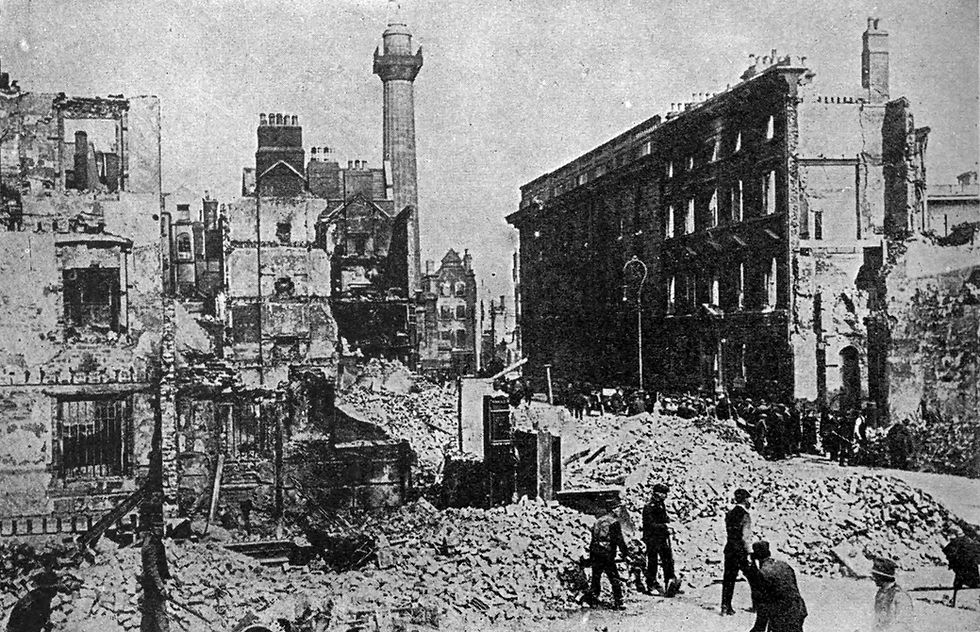
Background
In 1916, an armed rebellion designed to rid Ireland of British rule erupted on the streets of Dublin. Ireland had been granted a limited form of autonomy known as Home Rule, which was due to come into operation in 1914. The onset of World War I placed this scheme in jeopardy and led to the suspension of partial Irish freedom until the end of hostilities. This was an anathema to advanced Irish nationalists who would settle for nothing less than complete separation from Britain. Thus, they decided to strike for an Irish Republic before the war ended. Known today as the Easter Rising, this insurgency was a military disaster for the rebels. Defeated by a vastly superior force, the surviving rebels were amassed in Richmond Barracks. There, the rank-and-file were selected for internment, while the leadership was singled out for trial and execution. This act of judicial murder served to ensure that sixteen dead men became Irish martyrs. Perhaps most famously, James Connolly, the last of the condemned men, unable to stand, was strapped into a chair to be despatched by the firing squad. This act of capital punishment was a boon for Republican propagandists. This is the familiar narrative of the Easter Rising - one which extolls the virtuousness of the sacrifice made by the rebels who fell in the heat of battle. The civilian story of the Easter Rising recounts similarly unimaginable terror. Despite a rich corpus of civilian accounts, historians have largely neglected this story in favour of merely highlighting the statistics relating to civilian casualties. Mrs Sankey, a resident of 63 Merrion Square, left an illuminating diary that offers a profound account of the rebellion that adds to the narrative of the Easter Rising. This journal realised the price of €21,000 at auction in 2008. This article is an exploration of Mrs Sankey’s experiences as highlighted by her diary and includes notes that draw attention to areas that may be of particular interest to historians and researchers. The Diary Account Mrs Alice Maud Sankey, daughter of Major General William Boyd Saunders Gore Knox, married her husband Captain Richard Jones Sankey, formerly of the 5th Dragoons on 27 April 1905. Both parties were from affluent landowning families. Richard’s family seat was Fort Frederick, Virginia Co. Cavan and Alice’s was Belleek Manor, Ballina Co. Mayo.

Mrs Sankey provides a detailed account of life under fire. Her diary indicates that the Sankey’s were looking forward to visiting the Royal Hibernian Academy. Arriving just before noon, the Sankey’s spent just under an hour and had almost completed their tour of the exhibit when they were interrupted by the Keeper of the Academy who brought them the most distressing and alarming news. According to Mrs Sankey, he said, ‘Ladies and Gentlemen, I think you must go away now, I advise you to get home as quickly as you can, the Sinn Feiners have seized the Post Office and have now got into the house opposite this and are beginning to break the windows. The Military are coming and there will be probably firing in the streets, it is better for you to get home. We must stay here.’
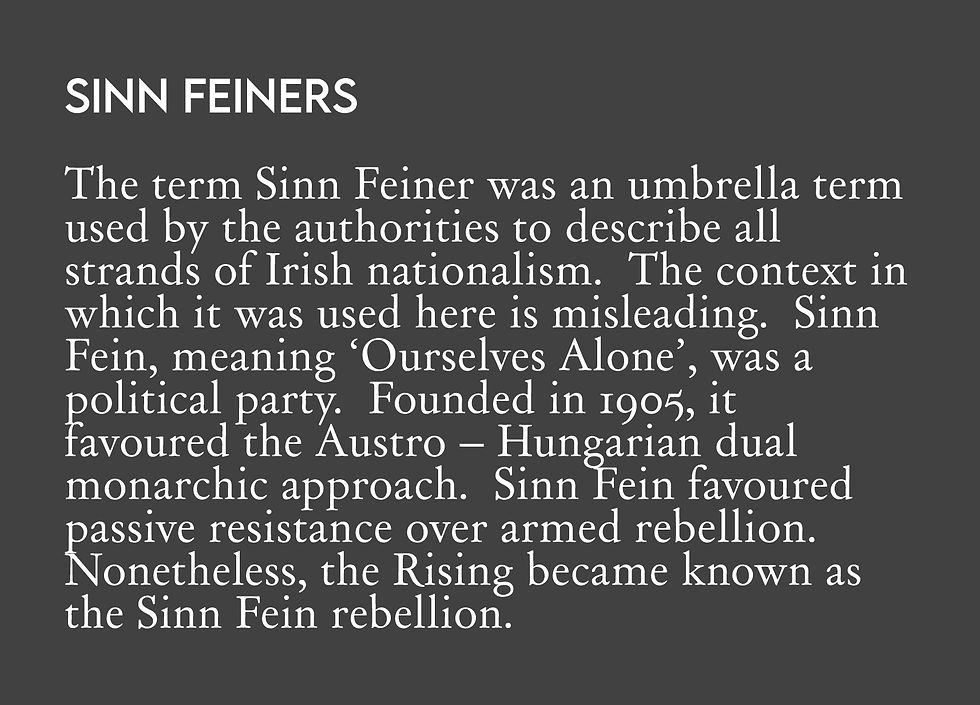
In the space of an hour, everyday life in Dublin had been transformed. Ensconced in the safety of the Royal Hibernian Academy, Mrs Sankey and her husband, Richard, were unaware of what was occurring on the streets outside. Upon leaving the Academy, Mrs Sankey noted, how the staff were shutting the windows and barring the doors, and how the sound of breaking glass greeted them on the street. Rushing away from the epicentre of the rebellion, the Sankey’s ran into a group of insurgents, who, thankfully, let them pass unharmed. Their journey took them down Brunswick Street and into Westland Row, where to Mrs Sankey’s horror the train station was under rebel control.
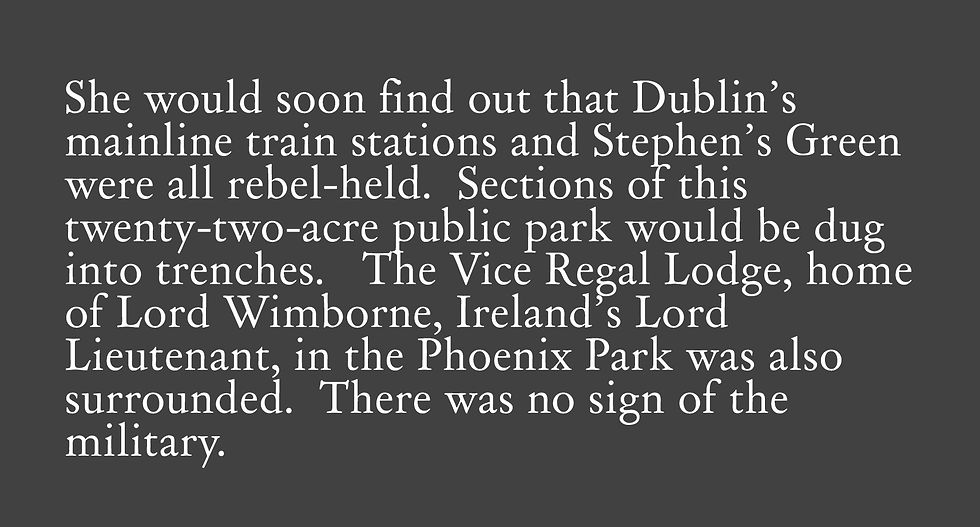
The military (or at least most of the officers) were at the races in Fairyhouse Co. Meath. The Commander-in-Chief, General Friend, was in London. Colonel Ellison was also absent, leaving Colonel Kennard, who was thought to be useless in charge, as Mrs Sankey confided in her diary. She did, however, hear a rumour that British Cavalrymen from the 5th Lancers charged down Sackville Street. This was not a rumour; the Lancers did indeed appear with fatal consequences. Henrietta Lynch, a neighbour of the Sankeys, appeared at their house frantic with worry. Her nephew, in British-army khaki and unarmed, had endured a torrid journey through unfamiliar streets to reach the safety of his aunt’s home. Henrietta enquired as to whether she could borrow some of Richard Sankey’s clothes for her nephew to wear. A bundle of clothes was duly made up and delivered to the Lynch residence. Shortly after, at 10.30 pm, Mrs Sankey went to bed fearful, because to the best of her knowledge law-abiding citizens were, ‘without protection, the Police having been withdrawn and the military not having come out.’
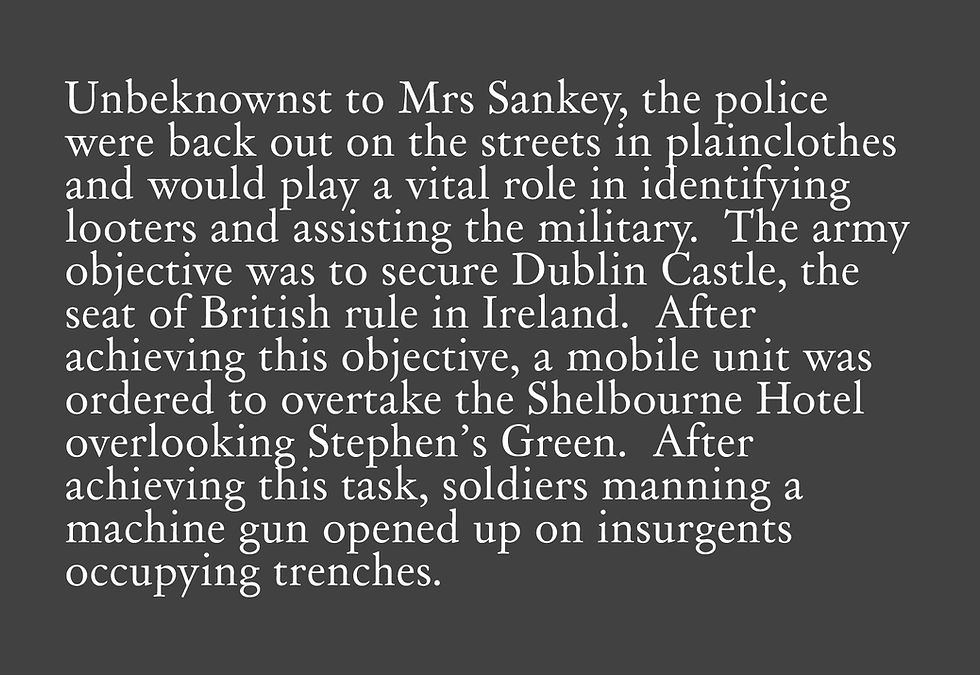
In nearby Merrion Square, the frightening sound of a machine gun staccato could be heard as it obliterated the usual melodic birdsong. Dublin’s suppliers were therefore cut off from their customers. Although the Sankey’s had a plentiful supply of eggs and were luckily able to obtain some milk, there was no cream or butter to accompany breakfast. There was some beef for lunch, but after that, she was unsure. They would have to brave the streets in search of any open shops. After breakfast, Mrs Sankey’s indicates that they decided to walk as far as Baggot Street in search of provisions.
They had barely left the house when they were called by Henrietta Lynch from an open window. She regaled them of the plight of her sister-in-law, Mrs David Lynch, who was forced to flee her home in the middle of the night. Mrs Sankey recorded the conversation in her diary. She wrote how Henrietta spoke to them about ‘… [Mrs David Lynch] living at 25 Lr Leeson Street, had her house broken into by Sinn Feiners, who got in from the roof from a skylight.’ The Sinn Feiners demanded control of the house and stated that if they were unimpeded, they would not harm the occupants. Otherwise, they would shoot them. Frightened for their lives, this family fled to the relative safety of Henrietta Lynch’s Merrion Square home. Mrs Sankey conceded that it ‘was a horrible state of affairs’ and proceeded on her way to Baggot Street in search of supplies and sustenance.
The shops in Baggot Street were all closed; the Sankeys could not purchase any provisions. Whilst on Baggot Street, they met some friends who apprised them of the latest developments. The Post Office was retaken by the military with one hundred casualties, but the rebels still held all the main stations with the exception of Amiens Street. Rumours like this were rife; the lack of any real news or communication provided a rich breeding ground for rumours. Mrs Sankey felt ‘quite cut off from the world, with no post, wires or papers’.

On Wednesday, 26 April 1916, Mrs Sankey woke to ‘such a lovely morning with the sun shining and birds singing as if we were in a peaceful world!’ The peace was short-lived as gunshots could be heard from 10 am. That afternoon, the firing would become more intense as a battle between British troops and Sinn Feiners, who were holding positions over Mount Street Bridge, would rage. This fight would last until 8 pm that evening. British soldiers would emerge victorious after throwing Mills bomb hand grenades into the last rebel-held position. Mrs Sankey’s captured this moment. She recalled how they ‘heard the big artillery guns and they fired 30 or 40 rounds also some machine guns’.
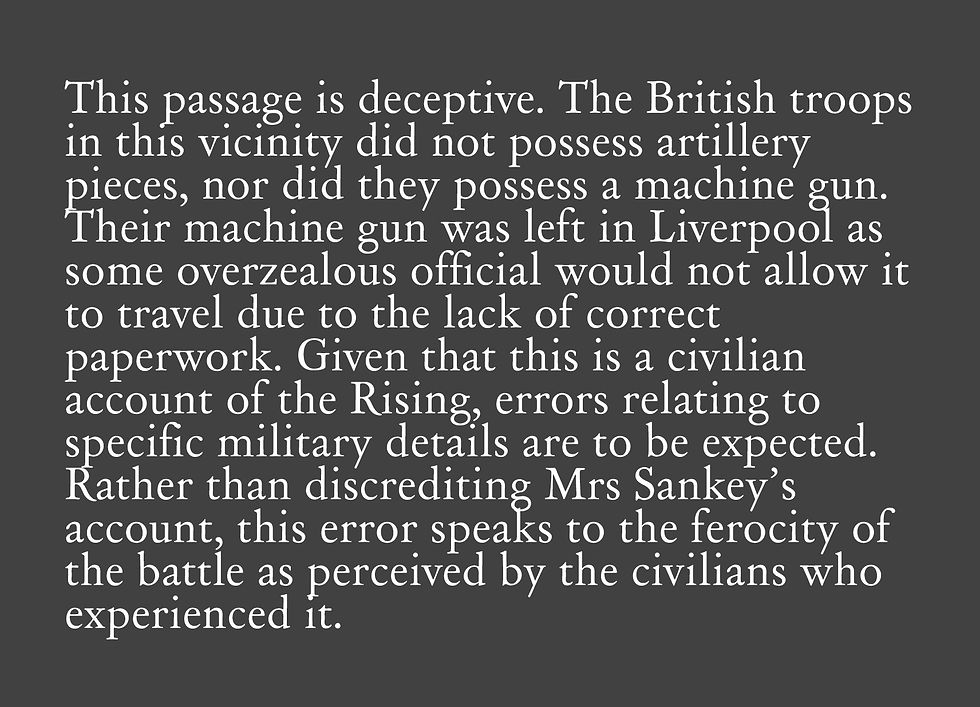
Sewing at home with her sister Sybil, both women wished there was something they could do. Two ladies arrived at her house seeking blankets, mattresses and pillows for a makeshift hospital at 40 Merrion Square under Dr Ella Webb’s stewardship. After supplying the hospital with the materials requested, Mrs Sankey and Sybil volunteered to assist the medical staff. Mrs Sankey commented, ‘One with a terribly shattered shoulder, another a poor boy of 17 his knee badly shot.’

Mrs Sankey stayed at this makeshift hospital until 8 o’clock that evening and promised to go back the next afternoon at 2 o’clock. On the way home, the sky was lit with flames coming from fires in the city centre near the art museum. As they went to bed that evening, the smoke from the fires could be seen billowing above Merrion Square. Mrs Sankey commented on the ‘frightful fire evidently near Sackville Street as we saw the smoke and terrific blaze’, just before bed.

Not long after waking on the following morning, Mrs Sankey would experience life under fire herself. According to her diary, a fusillade rang out whilst striking her house, sending bricks and mortar in several directions - thankfully without injury to anyone in the household. Mrs Sankey highlighted how it was thought insurgents were on her roof, saying, ‘there is an idea that Sinn Feiners are on top of all these houses and the troops on the north side of the square are firing on us frequently.’
There were reports of a ceasefire that Saturday evening, and it was indeed true that a ceasefire had taken place. However, news had not reached all of the rebel outposts until the following day, Sunday 30 April 1916. In military terms, the battle was over. Spiritually it had only just begun.
Conclusions
The smell of cordite that had permeated the air in Dublin was still lingering when the rebel propaganda machine sprang from the embers of a smouldering city. Extremely proficient rebel publicists spun a narrative that eulogised the virtue of the rebel martyrs. The dissident narrative was designed to be inculcated in the minds of successive generations. Mrs Sankey’s journal account of the Rising is one of many civilian accounts of this seismic event. The study of civilian accounts will serve to allow a multi-faceted history of the Easter Rising to emerge.
This manuscript journal in many ways is a microcosm of other civilian accounts of the Rising. All of the civilian narratives possess similarities, yet they are all equally different in their own right. The strength of diaries and personal letters is the emotions they convey. These sources place the reader in the heart of Dublin city during this epochal event. Each diary or letter is just one piece of a puzzle that offers a hitherto unseen view of events. Mrs Sankey’s journal takes her readers on a journey and provides valuable insight into life under fire, and in doing so, demonstrates that history is the sum of more than just one account.
----------------------
Further Reading
Charles Townshend, Easter 1916 The Irish Rebellion (Penguin, 2006)
Michael T Foy and Brian Barton, The Easter Rising (History Press, 2011)
Clair Wills, Dublin 1916 The Siege of the GPO (Profile Books, 2010)
Keith Jeffrey, The GPO and the Easter Rising (Irish Academic Press 2009)
Stephen is a 2nd year part-time PhD Candidate at Lancaster University. His thesis will conduct a spatial analysis of the General Post Office in the 1916 Easter Rising. It will focus on challenging the foundation myths of the Irish State. He is also keen on highlighting the civilian narrative of the Easter Rising.
Twitter: @AnIrishhistorian